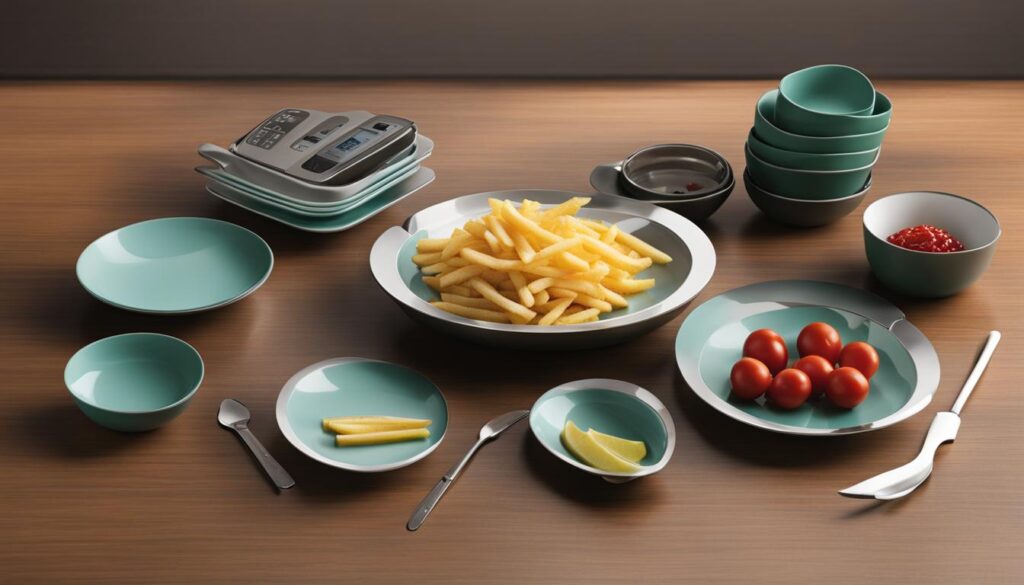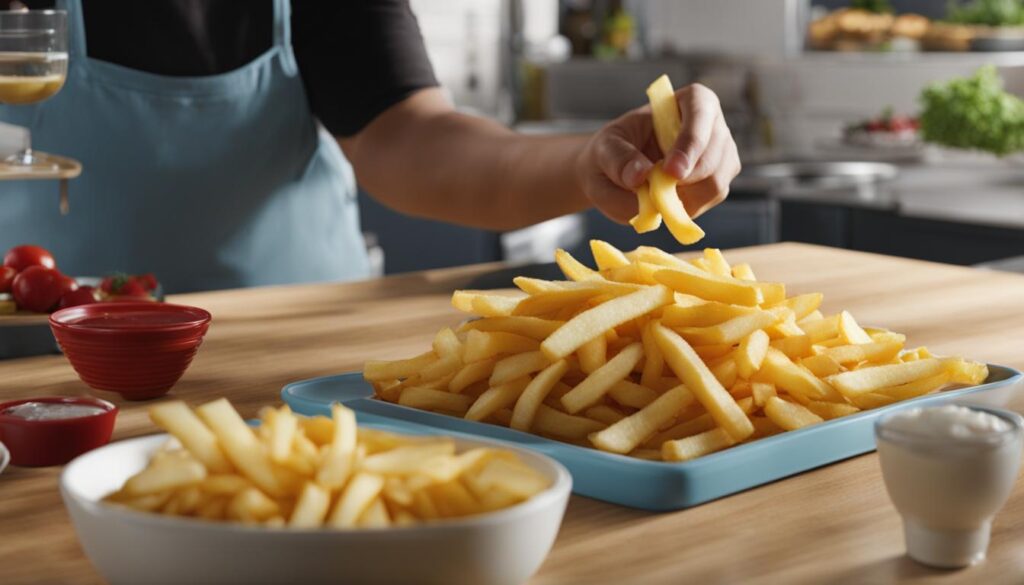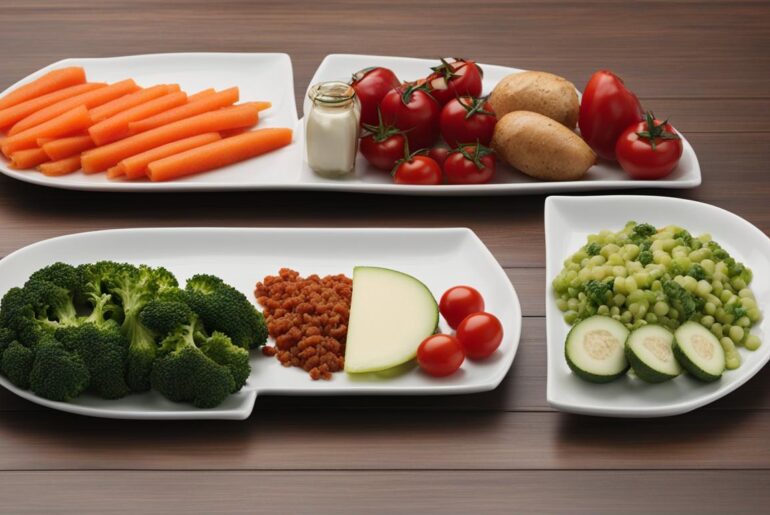Giving in to the temptation of crispy french fries is hard to resist, but managing portion sizes is key to maintaining a healthy diet (check out my post on managing portion sizes here). According to a study in the American Journal of Public Health, portion sizes of ultraprocessed foods like french fries have been increasing over time, which can contribute to weight gain and obesity. To help you enjoy your favorite indulgence without overdoing it, here are my top portion control tips for french fries (check out my post on portion control tips here).
First and foremost, opt for the smallest menu offering when ordering french fries. Many fast-food restaurants offer various sizes, so choose the smallest option to keep your portions in check. Additionally, consider sharing an order of fries with a friend or family member. Not only will this help you control your intake, but it also allows you to enjoy the experience together.
Another effective way to manage portion sizes is by choosing a vegetable as an additional side dish. Swap out a part of your fries for a side of steamed vegetables or a crisp salad. This way, you’ll still satisfy your craving for french fries while adding a nutritious element to your meal.
By implementing these portion control tips, you can enjoy your favorite french fries while maintaining healthy eating habits (check this post out). Remember, moderation is key when it comes to indulgent foods like french fries. Practice portion control and make mindful choices to achieve your health goals.
Key Takeaways
- Choose the smallest portion size when ordering french fries.
- Consider sharing an order of fries with someone.
- Opt for a vegetable as an additional side dish.
- Practice portion control to maintain a balanced diet.
- Moderation is key when enjoying indulgent foods like french fries.
The Impact of Portion Sizes on Obesity Rates
Ultraprocessed foods, including french fries, are being sold in larger sizes than ever before. The availability of bigger portions makes it harder to stick to normal portion sizes. This can lead to overeating and contribute to obesity rates. To combat portion distortion, limit your intake of ultraprocessed foods and choose smaller portion sizes whenever possible.
Reducing french fry consumption is an effective strategy for managing portion sizes and promoting healthier eating habits. Studies have shown that individuals who regularly consume large portions of french fries have a higher risk of obesity and related health issues. By reducing the size of your french fry portions, you can take control of your diet and improve your overall health.
Portion Control Techniques
- Opt for the smallest menu offering: When ordering french fries, choose the smallest size available. Avoid upgrading or supersizing your meal.
- Share an order with someone: Splitting a serving of french fries with a friend or family member can help reduce your individual portion size.
- Choose a vegetable as an additional side dish: Instead of ordering a large serving of french fries, opt for a healthier side option like a side salad or steamed vegetables.
By implementing these portion control strategies, you can enjoy your favorite foods, like french fries, while still maintaining a balanced diet and managing your portion sizes effectively (see my post here).
The Importance of Portion Control Plates and Tools

When it comes to managing portion sizes, utilizing the right tools can make a significant difference. Portion control plates are specially designed plates that have designated sections for different food groups, helping you visualize and control your portions effectively. These plates serve as a helpful visual guide, ensuring that you include a balanced mix of nutrients in your meals.
Using measuring cups and other portion control tools can also be instrumental in accurately measuring your food portions. By precisely measuring your servings, you can avoid underestimating or overestimating your intake. This level of precision can be especially useful for calorie-conscious individuals or those following specific dietary plans.
By following portion size guidelines, you can further enhance your portion control efforts. For example, experts recommend filling half of your plate with vegetables, a quarter with a lean protein source, and the remaining quarter with a healthy carbohydrate or whole grains. This guideline ensures that you have a well-rounded meal and achieve a balance of nutrients.
It’s important to note that portion control plates and tools are not restrictive or deprivation-focused measures. Instead, they empower you to make mindful choices and develop healthier eating habits. With these aids, managing portion sizes becomes more intuitive, leading to more sustainable lifestyle changes.
Remember, portion control is essential for maintaining a balanced diet and promoting overall health. By incorporating portion control plates and utilizing measuring tools, you can take control of your portions and make informed decisions about your food intake.
Tips for Portion Control When Eating Out
Eating out can be a delightful experience, but it can also pose challenges when it comes to managing portion sizes. Restaurants often serve larger portions, tempting us to overeat. However, with a few smart strategies, you can maintain portion control and enjoy your meal without guilt.
Here are some tips for portion control when dining out:
- Order the smallest size possible: Many restaurants offer different portion sizes for their dishes. Opt for the smallest size to ensure you’re not getting more food than you need.
- Ask for a half portion: If the smallest size is still too much, don’t hesitate to ask for a half portion. Most restaurants are accommodating and happy to adjust the serving size to meet your needs.
- Share a meal: Splitting a dish with a friend or family member is a great way to enjoy your favorite foods without overindulging. Not only will you control your portion size, but you’ll also save money.
- Avoid buffets and all-you-can-eat restaurants: Buffets can be tempting, as they offer unlimited food choices. However, they make it difficult to manage portion control. It’s best to steer clear of these establishments if you’re trying to watch your portion sizes.
- Fill up on a salad or soup: Before your main meal, start with a salad or a bowl of soup. This will help you feel fuller, allowing you to eat smaller portions of the main course.
“Controlling portion sizes when eating out can be challenging, but with some wise choices and mindful eating habits, you can enjoy a delicious meal while still maintaining your portion control goals.”
By implementing these simple yet effective strategies, you can navigate the world of eating out without compromising your portion control efforts. Remember, balancing indulgence and healthy habits is the key to long-term success.
Tips for Portion Control When Eating Out
| Tip | Description |
|---|---|
| Order the smallest size possible | Choose the smallest portion size offered by the restaurant. |
| Ask for a half portion | Request a half portion if the smallest size is still too much. |
| Share a meal | Split a dish with someone to control portion sizes and save money. |
| Avoid buffets and all-you-can-eat restaurants | Steer clear of establishments that promote unlimited food options. |
| Fill up on a salad or soup | Start your meal with a salad or soup to curb hunger and eat smaller portions. |
The Power of Drinking Water and Eating Slowly
When it comes to mindful eating and portion control techniques, two simple habits can make a big difference in reducing your food intake: drinking water before a meal and eating slowly (check out my post on portion control techniques here).
Drinking water before a meal can help you feel fuller, aiding in portion control. By hydrating before you eat, you can reduce your food intake without feeling deprived. Additionally, drinking water can help you differentiate between hunger and thirst cues. Oftentimes, we mistake thirst for hunger and end up overeating. By quenching your thirst first, you can better understand your body’s true hunger signals and make more mindful choices.
Eating slowly and taking the time to chew your food has been shown to have numerous benefits for portion control. When we eat quickly, we tend to consume larger amounts of food before our brain has a chance to register the feeling of fullness. By eating slowly, savoring each bite, and thoroughly chewing our food, we give our brain the opportunity to recognize when we’re satisfied. This can prevent overeating and help us maintain portion control.
So next time you sit down for a meal, remember to drink water beforehand and eat slowly. These simple yet powerful habits can help you reduce your food intake and practice mindful eating, ultimately leading to better portion control and a healthier relationship with food.
Benefits of Drinking Water and Eating Slowly:
- Feeling fuller before a meal
- Reducing food intake without deprivation
- Differentiating between hunger and thirst cues
- Preventing overeating by allowing the brain to register feelings of fullness
- Promoting mindful eating and portion control
Tips for Implementing Water and Slow Eating Habits:
- Always have a glass of water readily available before meals
- Drink a full glass of water before starting your meal
- Set aside dedicated time for meals, avoiding distractions like screens
- Eat smaller bites and chew each bite thoroughly before swallowing
- Savor the flavors and textures of your food, enjoying each bite
By incorporating these habits into your daily routine, you can take control of your portion sizes and reduce your food intake, leading to a healthier and more mindful approach to eating.
Using Visual Cues and Portion Control Aids

When it comes to portion control, visual cues can be incredibly effective. Our perception of portion sizes can greatly influence our eating habits and satisfaction levels. By utilizing certain visual cues and portion control aids, you can train your brain to recognize appropriate portion sizes and make mindful choices.
One simple visual cue is to use smaller plates and taller, thinner glasses. Research has shown that using smaller plates can trick our minds into thinking that we are consuming more food, even though the actual amount may be smaller. Similarly, using taller, thinner glasses for beverages can create an illusion of a larger volume, helping you feel more satisfied without overeating.
In addition to visual cues, there are various portion control tools available that can assist you in managing your portions effectively. One popular option is portion control plates. These plates have designated sections for different food groups, which can help you visualize and control your portions. By following the guidelines provided, such as filling half of the plate with vegetables and a quarter with protein, you can ensure a balanced and well-controlled meal.
Another useful tool is measuring cups. Measuring your food portions can provide a clear understanding of how much you are consuming, allowing for better portion control. Measuring cups can be especially helpful for high-calorie ingredients such as oils, sauces, and grains.
By incorporating these visual cues and portion control aids into your daily routine, you can make portion control a more intuitive and effortless practice. These tools provide tangible support in helping you maintain appropriate portions and make healthier choices.
Conclusion
Portion control is crucial for maintaining a balanced diet and managing overall food intake. By implementing these tips and strategies, such as choosing smaller portion sizes, utilizing portion control plates, and eating slowly, you can successfully control your portion sizes. This means you can enjoy your favorite indulgences, like french fries, in a mindful and balanced way.
Maintaining portion control is essential for achieving your health and weight goals. However, it doesn’t mean depriving yourself or completely giving up on the foods you love. Instead, it’s about making conscious choices and being mindful of your eating habits.
By practicing portion control, you can ensure that you’re getting the right amount of nutrients while avoiding overeating. Remember, it’s not just about the quantity of food you consume, but also the quality and how you approach your meals. So, embrace portion control and make it a part of your overall healthy lifestyle for long-term success.




